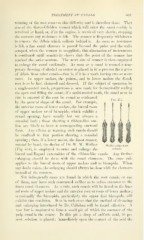Page 463 - My FlipBook
P. 463
TREATMENT OF CANALS. 461
reaming of the root removes this difficuhy and is therefore done. That
size of the Gates-Ghdden reamer Avhich will enter the canal readily is
revolved by hand, or, if in the engine, is revolved very slowly, stopping
the moment any resistance is felt. The reamer is frequently withdrawn
to remove the debris which collects behind it. As soon as resistance
is felt, a fine canal cleanser is passed beyond the point and the Malls
scraped, when the reamer is reapplied ; this alternation of instruments
is continued until sensitivity shows that the point of the reamer has
reached the pericementum. The next size of reamer is then employed
to enlarge the canal uniformly. As soon as a canal is reamed a tem-
porary dressing of alcohol on cotton is placed in it to prevent the ingress
of debris from other canals—that is, if it be a tooth having two or more
roots. In upper molars, the palatal, and in lower molars the distal,
root is to be first cleansed and dressed. If the subject of operation be
a single-rooted tooth, preparation is now made for hermetically sealing
the apex and filling the canal ; if a multi-rooted tooth, the canal next in
size is entered if the root be round as evidenced
Fig. 454.
by the general shape of the canal. For example,
the anterior roots of lower molars, the buccal roots
of upper molars or of bicuspids, which exhibit a
round opening, have usually but not always a
rounded body ; those showing a ribbon-like out-
line are likely to have a corresponding outward
form. Any eflPorts at reaming such canals should
be confined to that portion showing a rounded
opening ; thus, if a lower molar, the finest reamer,
rotated by hand, the device of Dr. AV. AV. Walker Walker pulp-canal
(Fig. 454), is employed to enter and enlarge the reamers.
buccal and lingual extremities of the ribbon-like canals. Any further
enlarging should be done with the canal cleansers. The same rule
applies to the buccal roots of npper molars and to bicuspids. When
any doubt exists, the enlarging should always be done with the cleansers
instead of the reamers.
Not infrequently cases are found in which the root canals, or one
of them, may have such contracted caliber as to refuse entrance to the
finest canal cleansers. As a rule, such canals will be found in the buc-
cal roots of upper molars and the anterior root or roots of lower molars
;
occasionally the bicuspids, particularly the upper first bicuspids, will
exhibit this condition. It is in such cases that the method of cleansing
and enlarging introduced by Dr. Callahan will be found eifective. A
rose bur is employed to form a small pit of which the entrance of the
pulp canal is the centre. In this pit a drop of sulfuric acid, 50 per
cent, solution, is placed ; immediately npon the contact of the acid the


